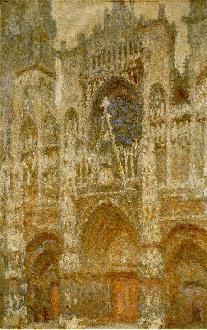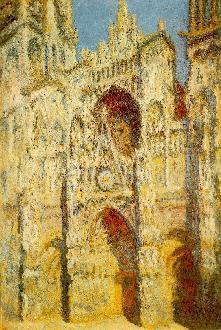1. "Who Has Stolen Our Feet?"
|
Exercise 1.1.:
The following questionnaire, for 'little visitors' to the Staatliche Kunsthalle, Karlsruhe (in Germany,) relates to the painting on the right, People by the Blue Lake, by August Macke (1887–1914.)
Read the questionnaire below and try to imagine answers to the questions. What ideas about art are being referred to implicitly? |
|
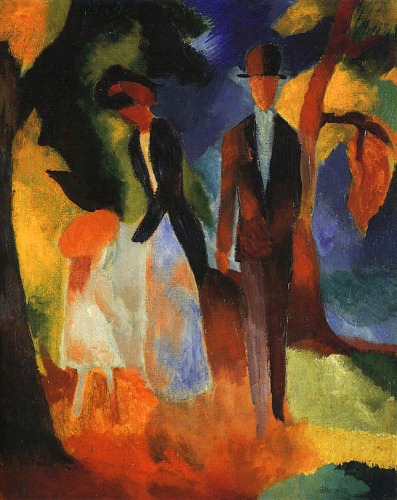 |
| When the family of the painter August Macke was taking a walk, the following dialogue might have taken place: |
| Daughter: | "Mother, why is it that we have not got any feet?" |
| Mother: | "Perhaps Father has not yet finished the painting?" |
| August Macke: | "Other things were more important to me than the feet." |
- In the summer of 1913, August Macke was staying near Lake Thun in Switzerland, to get some rest. He not only went for walks by the lake, but also did many paintings.
| August Macke: | "Do you think we are happy by this lake?" |
| Daughter: |
________________________________________
(Can you perhaps tell by the colours how the painter was feeling?) |
- Late in 1913, when August Macke painted this picture, what people were wearing was different from today. Everybody put on a hat when they went out.
Mr. Macke was wearing a bowler hat.
Mrs. Macke put on a plumed hat.
And their daughter had a round hat, which looks like an orange.
What else are they wearing?
________________________________________________________
-
Little bird in the tree: "But the painter has forgotten to paint so many things!"
Do you believe this? If you do, what do you think might be missing?
________________________________________________________
- Apart from the family there are other things represented in the painting.
Look closely. What other things are indicated by their colour?
________________________________________________________
- Where in the painting is there blue, where is yellow, and where red?
What does one call such colours?
____________________
- Apart from red, yellow and blue there are other colours, which the painter mixed with his brush on his palette. What mixed colours does one get?
| Red + Yellow | = __________ |
| Yellow + Blue | = __________ |
| Red + Blue | = __________ |
- Little Bird: "They are not painted accurately at all! I can't recognise the people clearly! The painter can't paint!"
Do you agree with that? Why do or don't you?
________________________________________________________
- August Macke and his painter-friends wanted to express themselves mostly by colour, not by painting accurately. It is not that they forgot the little things. They just left them out so as to be able to paint the colours better.
August Macke's friends were the painters Franz Marc, Paul Klee, Alexej Jawlensky and Wassily Kandinsky. In the Tate Gallery, or in books in the Library, look for some paintings by these artists and note down their titles:
________________________________________________________
________________________________________________________
| Daughter: | "Mother, Father has painted neither my hands nor my feet." |
| Mother: | "Still, although you have neither hands nor feet, you do have a lovely orange colour on your head." |
| August Macke: | "Much more important to me than feet and hands are the colours." |
| "THE COLOUR HAS STOLEN OUR FEET." |
If the conclusion at the end of the questionnaire seems a bit far-fetched, even absurd, comppare it with the one of the following passage, from an exhibition brochure:
Monet painted 30 canvases of Rouen Cathedral during two campaigns. He worked from buildings so close to the Cathedral that it almost appears that the west façade, with its recessed portals, elaborate rose window, pinnacles and towers, had been pressed up against the surface of the canvas itself; there is no foreground, nor any sense of recession, and it is the complex handling of brushwork, and the range of colours -- from cool greys to the intense red of the setting sun that sets the stone ablaze -- that is the subject of the paintings.
Or with the conclusion of an article with the title "The emotional brush" (The Economist, November 11th 2017):
The extraordinary final portraits of his gardener, Vallier, in both dark interior and blazing sunlight, confirm Cézanne's ultimate achievement. In this new art of portraiture, there is indeed emotion -- arising not from the subject's face but from the painter's brush.
2. Talking about Works of Art
Exercise 2.1.:
List some different kinds of works of art, and some different periods or schools.
Exercise 2.2.:
A work of art can either be a 'token' or a 'type'. It is a token if there is one well-defined object which is the original, and all copies or other versions of it are either reproductions or forgeries (-- if they claim to be the original.)
For each of the following, decide if it is a token- or a type-art:
| a. poetry, | b. architecture, | c. music, |
| d. sculpture, | e. cinema, | f. drama.
|
Exercise 2.3.:
Distinguish between the different uses of the word "novel" in the following statements:
- This novel has a wide social range of characters and many sub-plots.
- I have put this novel on the second shelf of the bookcase in my bedroom.
- The Chinese novel has a history of many centuries.
- novel. 1. ... 2. n. A fictitious prose tale published as a complete book.
- The novel has 120 chapters, all of about the same length.
- at the 'physical' level,
i.e. in terms of its causes, of atoms moving and nerve impulses;
- at the 'psychological' level,
i.e. in terms of the agent's reasons for it, of his desires and beliefs; and
- at the 'moral' level,
e.g. whether it was selfish or considerate.
An attempt to reduce description at one level to a lower one is called reductionism, (of which there are therefore two forms: from the moral to the psychological, and from the psychological to the physical level.)
It should be clear not only that these levels are distinct, but also that each depends on the one below it: without physical events there can be no psychological events, and the legal -- and moral -- distinction between manslaughter and murder depends on the (psychological) condition of mens rea, i.e. of the defendant's intention to harm or kill.
Exercise 2.4.:
For each of three different events (or situations,) three possible descriptions are given below. In each case, decide which of the descriptions is
- 'physical',
- 'psychological', and
- 'moral'.
- His finger moved 2 cm against the pressure of the spring.
He deliberately shot her.
He murdered her in cold blood.
- They took the gold from the travellers so as to give it to the poor.
They stole from the rich and helped the poor.
The gold moved from the bags of some people, via the hands of a few other people, to the pockets of many others.
- He is a friend of mine.
He and I spend a lot of time together.
He and I have the same interests and like one another.
The same kind of distinction can be drawn in the case of works of art, and one can therefore talk about different aspects of the same painting, for instance:
- at the 'material' level,
about such things as the pigments applied to the canvas or the colours used,
- at the 'psychological', or 'biographical', or 'historical' level,
about the audience's reactions, or that of critics, or the artist's intention, or his life, etc., or
- at the 'aesthetic' level,
about the style in which it is painted and whether it is beautiful, say.
Again, the attempt to reduce description at one level to a lower one is called reductionism.
It is characteristic of the 'highest' levels, the moral description of an action and the aesthetic description of an object, that they involve value judgments: being considerate is better than being selfish, and being beautiful is better than being ugly, (unless there is some higher artistic purpose.)
One form of reductionism, then, attempts to define moral and aesthetic value in psychological terms: an action is morally good, because it gives pleasure, say, (to me or to others, depending on one's morality;) and an object is a work of art because the artist intended to make a work of art or because it pleases me, (again depending on one's aesthetic theory.)
Exercise 2.5.:
For each of three different categories of the arts, three possible descriptions of some work in that category are given below. In each case, decide which of the descriptions is
- about the 'material' used,
- 'psychological', or 'biographical' or 'historical', and
- properly 'aesthetic'.
- fiction:
- The feelings one has in the last but one chapter balance those in the first two chapters.
- The style of one of the chapters is modelled on that of Freud's case histories.
- The effect of the last but one chapter of the novel is really quite sickening.
- painting:

From an obituary in The Economist, October 4th 1997:
- Before he became a pop artist, he had an oeuvre of representational painting that anyone could appreciate. ... Then, in 1965, Life magazine asked: "Is he the worst artist in America?" The question was not so much a provocation as confirmation that he had become the most famous artist in America.
- But it was [sic] for his work in the 1960s that he has a place, of whatever size, in the history of art.
- His technique was certainly not despicable. His art school training, followed by experience as a draughtsman, was evident in the precision of his work.
|
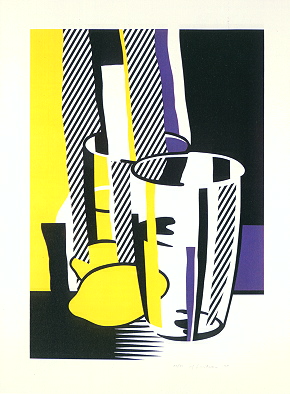
|
- music:
- In the Adagio-introduction the bassoon intones a soft lament over the dark harmonies of the lower strings.
- The first movement draws the listener irresistibly into the magic of its contrasting moods.
- Second movement (Allegro con grazia.) A welcome contrast to the first.
Exercise 2.6.:
Give descriptions at each of the three levels in question Exercise 2.5. of
- some poem you like,
- a dramatic performance,
- a building.
While I cannot then prove the reductionist wrong, I can say that he or she is, in my opinion, missing out on something; and I can decide that there is no need to take such a person's views seriously when they claim to be talking about moral or aesthetic value.
Liking something or not is a subjective, personal matter, it is an attitude and at the psychological level. But it is only at the aesthetic level that we can make aesthetic judgments: that a given object -- in a wide sense -- is or is not a (good or great) work of art.
To this judgment, other aspects of the work may of course be relevant, but only in so far as they contribute to our appreciation of the work.
Exercise 2.7.:
Take a work of art you know and like, of any kind, and try to describe the following aspects of it, in one short sentence each.
In which way are they relevant to your understanding of the work and the esteem in which you hold it?
- The historical situation in which it was made,
- the artist's life at the time,
- the style, (i.e. the context of other works in which it is helpful to view the particular work,)
- the originality of the work, (i.e. what makes it different from works that had been made before,)
- the financial reward the artist received, and its present-day price,
- the social statement, if any, and the audience for whom it was made and who listen to or view it now,
- the audience's and the critics' view of the work, now and in the past,
- when you first saw or heard it, and the appeal it has for you now.
3. Form and Content
One way of approaching a work of art may be in terms of the distinction between form and content, and of the relationship between them.
In the case of language the distinction is quite clear: the content is the meaning and the form is how that meaning is expressed. In normal communication, the formal aspects of a sentence are not what one is interested in but only the meaning; and the two aspects of a sentence are quite independent, so that the same meaning can be expressed using quite different constructions (synonymous sentences,) and the same construction can even express different meanings (ambiguity.)
But there is a certain use of language where form is relatively more important, as for instance in poetry, where different lines may rhyme or have the same metre; and where the two aspects are made to partly coincide, as for instance by means of alliteration: e.g. "Of Mice and Men". In the case of a work of art, in so far as it must be recognisable as being intentional and constructed, we can expect its form to be essential to it and not completely separable from its content.
So one way of approaching a work of art is in terms of the relationship between its form and the content, in so far as that distinction can be made.
Exercise 3.1.:
Try to discover any formal aspects of the above four paragraphs. (Not that I would claim that the passage was a work of art ...)
Exercise 3.2.:
| Consider a landscape photograph by Anselm Adams, say, or one of the flower photographs by Robert Mapplethorpe. (The screen display can of course not do the originals justice ...)
Discuss what makes a work like this different from a snapshot. |
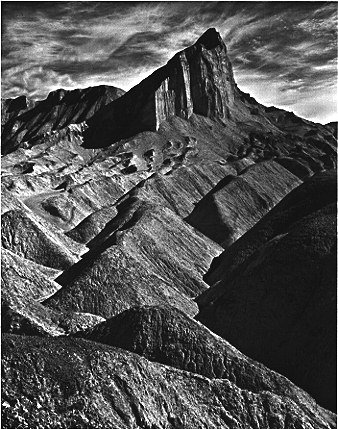
|
Anselm Adams, Manly Beacon, Death
Valley National Monument, California.
|

|
Robert Mapplethorpe, Parrot Tulips, 1988.
(Robert Mapplethorpe, who died in 1989, is best known for his photographs of human bodies, male and female, many of them erotic or even sexually explicit. You may want to discuss what formal aspects, if any, make those photographs different from pornography, despite their content, i.e. despite what they show.
Suggested links:
1 –
2 –
3 –
4.)
|
Exercise 3.3.:
Each of the following statements could be made in response to a certain novel. For each statement decide whether it is about the form of the novel, or about its content, or whether it is an aesthetic judgment, or not about that work at all.
- For a long time, the main character of the novel is weak and avoids all commitment.
- The novel has a powerful main character.
- Some of the formal aspects of the novel reflect the author's moral judgments on the main character.
- I really enjoyed the descriptions of their trip up the river Nile.
- The first few chapters all have different narrators.
- That novel has been important in my friendship with the person who gave it to me, some ten years ago.
Exercise 3.4.:
For three different categories of the arts, three possible responses to some work are given below:
- one relating to the formal properties of the work,
- another concerning its 'content', and
- a third which is not about the work at all.
In each case, decide which response is which.
- cinema:
I have seen the film many times, once even in French.
The film is based on a novella by Thomas Mann, although the main character has here become a composer.
The music, most of it by Gustav Mahler, is more important than the dialogue.
- architecture:
The building houses the most important museum of modern art in Paris, as well as a public library.
The support system of the building, including access, has been put on its outside.
The building is in the centre of Paris, near Châtelet.
- music:
Unlike most pop songs, this one has more than one theme and uses various contrasts: between solo and choir, between a cappella and hard rock, etc.
It is my favourite song by that group.
After all the excitement, the song leaves one with a very satisfied feeling.
Exercise 3.5.:
In the case of certain of the arts, such as traditional fiction and representational painting, it is not too difficult to see what is meant by content and form. Try to describe what might correspond to 'content' in the case of the following:
| a. poetry, | b. architecture, | c. music, |
| d. sculpture, | e. cinema, | f. drama.
|
|
The distinction between form and content is useful in discussing the work of the American architect Frank Lloyd Wright, 1869 -1959, for instance. Early in his career Wright worked for Louis Sullivan, whose phrase "form follows function" can be considered as the basic tenet of modern architecture.
|

|
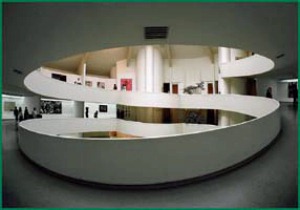
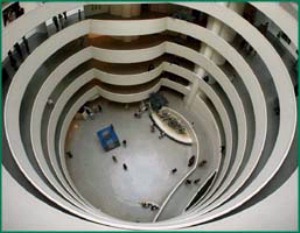

|
In his design of the Guggenheim Museum, New York, 1943 (built 1956 -1959,) Frank Lloyd Wright employed one of his characteristic formal elements, an atrium, around which the exhibition space is built.
Our contention is not only that formal groups or types exist in Wright's architecture but also that they constitute the essence of his approach to design. ... the basic types of hearth, atrium, and tower are the starting points and guiding concepts for almost all of his designs. Wright spoke about function and form as a unity. Through the use of types, he is able to embody the idea of dwelling, community, and place that can transform to adopt a wide variety of expressions while retaining their basic integrity.
P. Laseau, J. Tice, Frank Lloyd Wright:
Between Principle and Form, 1992.
"Form follows function -- that has been misunderstood," he [Wright] said. "Form and function should be one, joined in a spiritual union." He mentioned a well-known architect. "He exposes all the function on the top and puts the form below. It's as if you were to wear your entrails on top of your head."
Patrick J. Meehan,
Frank Lloyd Wright Remembered, 1991.
|
Exercise 3.6.:
In terms of this distinction of content and form, consider again the discussion of the painting by August Macke, (section 1. above): especially the little bird's 'complaints' in c. and g., and the eventual conclusion as to where their feet have gone.
4. Formal Aspects of a Work of Art
While the 'naive' approach to art -- and to particular works of art -- may be largely in terms of content, there has been a school of criticism which has concentrated on the formal aspects. Thus, according to Roman Jakobsen, who was one of the representatives of this school of thinking,
The distinctive feature of poetry lies in the fact that a word is perceived as a word and not merely a proxy for the denoted object or an outburst of emotion, that words and their arrangements, their meaning, their outward and inward form acquire weight and value of their own.
The following exercise takes you through an example of a formalist examination of a poem.
Exercise 4.1.:
In a lecture given at Oxford University, Roman Jakobsen compared two versions of a poem by William Butler Yeats (1865 -1939,) which the poet had worked on for much of his life.
Read the two versions printed below, and then complete the table on its formal/ grammatical aspects. Which version shows more regularities?
The Sorrow of Love
(first printed version, 1892)
- The quarrel of the sparrows in the eaves,
The full round moon and the star-laden sky,
And the loud song of the eversinging leaves,
Had hid away earth's old and weary cry.
- And then you came with those red mournful lips,
And with you came the whole of the world's tears,
And all the sorrows of her labouring ships
And all the burden of her myriad years.
- And now the sparrows warring in the eaves,
The crumbling moon, the white stars in the sky,
And the loud chaunting of the unquiet leaves,
Are shaken with earth's old and weary cry.
The Sorrow of Love
(final version, 1925)
- The brawling of a sparrow in the eaves,
The brilliant moon and all the milky sky,
And all that famous harmony of leaves,
Had blotted out man's image and his cry.
- A girl arose that had red mournful lips
And seemed the greatness of the world in tears,
Doomed like Odysseus and the labouring ships
And proud as Priam murdered with his peers;
- Arose, and on the instant clamorous eaves,
A climbing moon upon an empty sky,
And all that lamentation of the leaves,
Could but compose man's image and his cry.
| I | II | III |
| 1, 2 | 3, 4 | 1, 2 | 3, 4 | 1, 2 | 3, 4 |
| a. | connectives in each couplet (i.e. pair of lines): |
| first | copulas ("and") | | | | | | |
| prepositions | | | | | | |
| final | copulas ("and") | | | | | | |
| prepositions | | | | | | |
| b. | "-ing": |
| first | | | |
| final | | | |
| c. | nouns: |
| first | | | |
| final | | | |
| d. | plurals/ plurals in rhymes: |
| first | / | / | / |
| final | / | / | / |
| e. | prenominal attributes in each line: |
| first | | + | + | + | + | + | + |
| sum = | | | |
| final | | + | + | + | + | + | + |
| sum = | | | |
| f. | definite articles ("the") in each line: |
| first | | + | + | + | + | + | + |
| sum = | | | |
| final | | + | + | + | + | + | + |
| sum = | | | |
| g. | occurrences of certain words: |
| final | "his" | |
| "that" | |
| "all" | |
On the basis of your observations, try to complete the following statement:
"Of course Yeats did not sit down to count words in his poems, but he did work very hard to make this poem better, and in the process ..."
How do you feel about this (possibly extreme) example of a formalist approach to a poem? What role, if any, do you think this kind of analysis does have to play in our consideration of works of art?
However, as the dictionary definition makes explicit, one can take quite different views of this approach: "formalism n. 1. scrupulous or excessive adherence to outward from at the expense of inner reality or content."
An attempt at a conclusion:
While a particular experience may be the starting point of the creation of a poem, say, the poet does not only record his experience or his reaction to it, or express his feelings. In working to make it 'a good poem' he then concentrates on formal aspects, such as rhyme and metre and grammatical structure, and only through this further work does the poem achieve universality, so that it no longer depends on the particular experience but can be read, understood and enjoyed by people far removed in culture or time. Through this process, too, the poem can become open to interpretations, behind his back, as it were, which were not on the poet's mind.
If the poet didn't want to do anything other than represent his experience, or express his feelings, then there would be no reason for the voluntary formal constraints of rhyme and metre, say, and he would just write down what comes to his mind. (Many 'student poets', I am afraid, mistake the sincerity of the expression of their feelings for evidence that what they are writing is poetry ...)
Exercise 4.2.:
What kinds of voluntary or conventional formal constraints, or options, are there in the following art forms, which raise works above being just representational, or just expressive?
a. photography, b. fiction, c. film.
5. An Artist's View
Oscar Wilde (1854 -1900) was an Irish writer of some notoriety, capable of pointed irony, many of whose (sometimes self-) mocking lines have become well-known quotes, such as: "There is only one thing worse than being talked about -- and that is not being talked about."
In reading the following passage, try to see what general points about art and aesthetic judgment he is implicitly referring to.
The artist is the creator of beautiful things.
To reveal art and conceal the artist is art's aim.
The critic is he who can translate into another manner or a new material his impression of beautiful things.
The highest, as the lowest, form of criticism is a mode of autobiography.
Those who find ugly meanings in beautiful things are corrupt without being charming. This is a fault.
Those who find beautiful meanings in beautiful things are the cultivated. For these there is hope.
They are the elect to whom beautiful things mean only Beauty.
There is no such thing as a moral or an immoral book.
Books are well written, or badly written. That is all.
The nineteenth century dislike of Realism is the rage of Caliban seeing his own face in a glass.
The nineteenth century dislike of Romanticism is the rage of Caliban not seeing his own face in a glass.
The moral life of man forms part of the subject-matter of the artist, but the morality of art consists in the perfect use of an imperfect medium. No artist desires to prove anything. Even things that are true can be proved.
No artist has ethical sympathies. An ethical sympathy in an artist is an unpardonable mannerism of style.
No artist is ever morbid. The artist can express everything.
Thought and language are to the artist instruments of an art.
Vice and virtue are to an artist materials for an art.
From the point of view of form, the type of all the arts is the art of the musician. From the point of view of feeling, the actor's craft is the type.
All art is at once surface and symbol.
Those who go beneath the surface do so at their peril.
Those who read the symbol do so at their peril.
It is the spectator, and not life, that art really mirrors.
Diversity of opinion about a work of art shows that the work is new, complex, and vital.
When critics disagree the artist is in accord with himself.
We can forgive a man for making a useful thing as long as he does not admire it.
The only excuse for making a useless thing is that one admires it intensely.
All art is quite useless.
Oscar Wilde, The Picture of Dorian Gray, 1891. Preface.
Exercise 5.1.:
- Oscar Wilde quite clearly thinks that moral issues are irrelevant to aesthetic judgment. Do you agree?
(A particular instance of this is the question, asked above, of whether many of Robert Mapplethorpe's best-known photographs should be considered as pornography.)
- Conversely, what moral responsibility, if any, do you think we have towards works of art?
Exercise 5.2.:
After ten minutes' preparation by the two groups, hold a formal symposium between a group of highly intelligent, but quite unemotional 'Martians' and a group of terrestrial 'experts', on what art is and why 'earthlings' have it.
Lecture: Art and Aesthetics
- Introduction
Th.o.K., as before, is about how we justify knowledge in different areas,
knowledge having been defined as appropriately justified true belief;
here: how do we make aesthetic judgments?
aesthetics is concerned with concepts like art, beauty, taste;
hence also: what counts as appreciating art?
We must not expect a simple account:
when talking about art, people do not ...
come to quick conclusions,
usually agree,
follow simple procedures, etc.
Cf. moral discourse:
requires discussing actual situations and motives,
not just looking theoretically at people's behaviour,
i.e. it is not enough to find and apply simple rules.
We must not expect an abstract, impersonal account either:
talking about art depends on ...
previous experience,
the present situation,
personal reaction, etc.
Cf. moral discourse, again:
requires making personal choices, taking a position,
i.e. it is not enough to say: "But what if someone ...?"
Talking about art necessarily involves value judgments,
judgments of aesthetic value:
what makes something a (good) work of art?
Can consider only a few issues here:
not the relation between art and beauty, for instance;
nor the role of originality, what we mean by style, etc.,
e.g. whereas an object almost like this chair is a chair, an object almost like a Rembrandt is a forgery;
nor the differences between the different arts,
e.g. I don't have a 'forgery' of Shakespeare's works on my shelf,
and people do not go to see a reproduction of his Twelfth Night.
- Aesthetic Value
What is aesthetic judgment based on?
i.e. what do we mean when we call something a work of art?
There are three possible 'locations':
- the spectator, audience, etc.:
It is a work of art because ...
it makes me/us feel good, gives pleasure,
the critics say it is,
it hangs in a museum, is played in concert halls, etc.,
it commands a price on the market;
however, then the judgment would ...
depend on the person, and
depend on fashions.
- the artist, creator, etc.:
It is a work of art because ...
the artist wanted to create a work of art,
it required the artist's technical skill;
however, then the judgment would ...
require us to know about the artist's intentions, and
have to agree with the artist's,
who is not necessarily the best interpreter of his own works.
These two views are reductionist:
i.e. aesthetic value is purely subjective, as liking something,
i.e. depending on the person(s) only.
value judgments are reduced to psychological statements;
Reductionism cannot be proved wrong, perhaps,
however, one can try to persuade reductionists that there may be something they are missing;
and there is a (moral) choice involved: how seriously do we take art, or artists and their works?
Cf. reductionism in moral discourse,
such as the following views:
we call good that which helps us, or
everyone acts from selfish motives anyhow;
but again, reductionists may be missing something -
such as the difference between Hitler and Mother Theresa.
- the work itself:
Although we disagree in our aesthetic judgments,
it is still about the work we talk and argue,
not just about our feelings, or the artist's, etc.,
moreover, someone else can help us to understand and like a work better --
this is the role of critics --
so the understanding/ liking is not purely private.
So aesthetic value can be objective,
similarly to the judgment that something is red, say,
(which can also sometimes be difficult to make,)
but based on subjective experience, and not universal,
i.e. it need not be shared by all people.
- Form and Content
This is one aspect of works of art, but there would be others:
e.g. art as communication.
Can distinguish (usually/ often/ perhaps)
between content: what is represented --
the story, the purpose, the feelings expressed, etc. --
and form: how it is represented --
materials used, style, structure, etc.
Cf. the meaning of a sentence and the way it is put,
e.g. the active and passive forms of a sentence.
A typical naive approach focuses on one to the exclusion of the other:
looking at content only:
"What a pretty dress the lady in the painting is wearing!"
looking at form only:
"The lady in the painting could step right out of it!"
Such observations are not aesthetic judgments,
but they can contribute to the judgments we make.
Responses to form and content:
- Formal aspects are essential,
and focusing on content not enough
(-- which is what most people are inclined to do):
- Works of art have richer interpretations if we include formal aspects,
and conversely, if formal aspects are irrelevant it cannot be much of a work of art, can it? --
for example
detective novels ("whodunnits") are held together by plot only,
romantic novels appeal only via the readers' emotional response,
much pop-music depends on image and certain feelings it gives rise to, etc.
- Artists often deliberately limit themselves formally,
although this restricts the artist's ability to express himself, doesn't it? --
for example
poetry v. novels,
black-and-white v. colour photography.
- If we pass over formal considerations, abstract art cannot be understood:
abstraction is an historical development, perhaps in all the arts:
in painting:
early representational: the painting as 'a window'
--> impressionism, expressionism: 'the mind's view'
--> abstract art: 'the surface has taken over;'
or in music:
dance music, romantic music, etc.
--> minimalism may correspond to abstract art.
Not that traditional painting, say, lacks formal structure:
but when the content is too plain too see, many people miss formal aspects.
- The formal aspects of a work of art can be, and are, experienced by people who are unaware of them, or even deny they are there,
e.g. the fans do respond to the (often simple) formal structure of a pop-song.
- But formal aspects are not enough,
and focusing on them an 'empty' exercise
(-- which was the danger the Formalists fell into):
- noticing the structure of a painting does not tell us why the artist chose to do it that way;
- the pleasure of understanding how it is 'put together' is only one aspect of properly appreciating a work;
- counting words does not help one to understand a poem, though it may help one appreciate some technical aspects of it.
- A possible synthesis,
(-- when we can think in terms of that distinction):
aesthetic interest lies mainly in the interaction of content and form;
for example:
the title of Steinbeck's Of Mice and Men (from Robert Burns);
form: alliteration,
content: parallel fates;
the first and last verses of Blake's "The Tiger":
form: the tiger's "symmetry" does not rhyme,
content: the tiger's wildness cannot be caught
(-- but things are of course not usually so simple/trivial.)
- How to Approach Works of Art
We must be prepared to make an effort:
understanding art may require work, learning,
despite the fact that we can clearly see, hear, etc.;
contrast a cheap thriller, pop music, etc., which require no effort.
Should consider such things as
the artist's life and times,
the tradition and style he works in,
the views of critics,
but also our own emotional reaction, likes and dislikes:
while aesthetic judgment cannot be reduced to any of these, they can contribute to our understanding.
When someone rejects a work, they often ...
don't understand its context/ style/ technique/ etc.,
have made no effort even to understand it
-- like trying to judge a book without being able to read the language.
With humility:
we must be careful,
knowing that many works we consider great now were booed at first;
we should try to learn from others,
knowing that some people ('critics',) having spent more time, may have a better understanding;
we should respect the work,
knowing that even if it only seems like noise or a child's drawing to us, the artist made the effort to make it.
But also critically (-- which does not mean negatively):
true evaluation requires appreciation --
if one is going to condemn a work,
one must have understood what the artist tried to do,
e.g. have studied the artist's school, his style;
true appreciation requires evaluation --
and there are frauds, over-estimations, etc.
Could perhaps start by asking questions like:
What is the relation between form and content?
How is each part related to the whole?
-- e.g. recurring musical motifs, a colour pattern.
What do different works by the artist have in common?
-- recognising the painter, the composer, etc., does require some understanding.
What was the artist's social context, why did he bother?
-- the answer "To earn money." is too simple, and usually untrue.
- Personal Attempt at a Definition
What is a work of art?
A work of art is an object towards which it can be rewarding, though not necessarily for everybody, or even a majority, to take a certain attitude.
What does this aesthetic attitude consist of?
(-- the definition may have to be largely negative):
Not looking for such things as
practical usefulness,
cf. Oscar Wilde: "All art is quite useless."
financial gain,
purely sensual pleasure --
although the object may have all these aspects as well;
but investing a free floating attention,
beholding the whole work,
always wondering: why this particular note, brushstroke, etc.? why here?
Note the responsibility placed on us, the audience, by this definition!
There is then possible a high form of communication,
between the artist and us,
and a tremendous pleasure and satisfaction.
Teaching Notes:
-
2. Talking about Works of Art
Exercise 2.1.:
-
collect some examples of the arts, and discuss:
cinema, architecture, dance, etc.
primitive art, modern art, abstract art, etc.
-
Exercise 2.2.:
-
| a. type | b. token (?) | c. type/ token |
| d. token | e. type | f. type/ token.
|
note, in the cases of c. and f., the distinction between a composer's or playwright's work, which is a type, and a performance of that work, which is a token of that type.
-
Exercise 2.3.:
-
- (content of a) work of art
- the book, an object
- an art form
- the word "novel", (which is ambiguous: "1. adj. Of new kind, strange, hitherto unknown.")
- (form of the) work of art
(-- Cao Xueqin, The Story of the Stone, first printed 1792.)
-
Introduce the three kinds/ levels of descriptions by giving i. a physical description of an event -- a man sits between the steering wheel of a moving car with 0.2% of alcohol in his blood -- and ask students to give ii. a psychological and iii. a moral descriptions of the same event: e.g. "He believes he can drive safely," or "I am afraid," and "He is being reckless."
Psychological descriptions must of course be about persons, and just as the psychological description of an action can either be about the agent or about someone witnessing the action, (as in the above example,) so it can in the case of a (purported) work of art be either about the artist, or about the audience/ spectators, (and critics in particular, perhaps.)
Under their different descriptions events can have quite different properties, and we must avoid fallacies due to not distinguishing between the different levels, e.g.
- stealing (= iii.) is not just taking (= ii.), and
- from the fact that you are students and I am teacher (= i., ii.) it does not follow that you ought to always do as I say (= iii.)
-
Exercise 2.4.:
-
- i. -- ii. -- iii.
- ii. -- iii. -- i.
- iii. -- i. -- ii.
-
Exercise 2.5.:
-
- iii. -- i. -- ii. (-- D. M. Thomas, The White Hotel, 1981.)
- ii. -- iii. -- i. (-- Roy Lichtenstein, 1923 -1997.)
- i. -- ii. -- iii. (-- Tchaikovsky, Symphony No. 6 (Pathetique).)
-
3. Form and Content
-
Exercise 3.1.:
-
various symmetries between the four paragraphs:
- length/ numbers of lines,
- 4th echoes 1st,
- "in the case of" in 2nd and 3rd,
- "... ; and ..." in 2nd and 3rd;
this is an extreme example of a 'formalist' approach --
cf. Russian formalism, in the 1920s, suppressed for political reasons in the '30s.
-
Exercise 3.2.:
-
choice of subject, composition, technique, context, etc.
-
Exercise 3.3.:
-
- content,
- form (or content?)
- aesthetic,
- not about the novel,
- form,
- not about the novel;
(-- John Fowles, Daniel Martin, 1977.)
-
Exercise 3.4.:
-
- iii. -- ii. -- i. (-- Death in Venice, 1971, directed by Luchino Visconti.)
- ii. -- i. -- iii. (-- Centre George Pompidou, opened 1977, architect Richard Rogers.)
- i. -- iii. -- ii. (-- Queen's "Bohemian Rhapsody", 1975.)
Students should try to find, or make up, similar sets of three responses to works in other categories.
-
Exercise 3.5.:
-
- a situation described, the emotions expressed,
- the function of the building,
- the (progression of) emotions (-- cf. Susan K. Langer, Philosophy in a New Key, 1942,)
- what is represented,
- the plot of the film,
- the story acted out on stage.
-
Exercise 3.6.:
-
c. is a complaint about content, g. a complaint about form;
conclusion: the resolution requires a joining of a formal aspect (use of colour) and content (their feet).
-
4. Formal Aspects of a Work of Art
In the visual arts, the styles that developed at the same time as formalism, are impressionism, cubism, expressionism were abstract: in all of these the painting, say, is not a 'window' (only,) but a surface, form to some extent takes over from representational content.
Similarly, in music it is twelve-tone music that developed, in which the listener is denied a harmonic or emotional reference point.
-
Exercise 4.1.:
-
The results of Roman Jakobsen's counting:
| I | II | III |
| 1, 2 | 3, 4 | 1, 2 | 3, 4 | 1, 2 | 3, 4 |
| a. | connectives in each couplet (i.e. pair of lines): |
| first | copulas ("and") | 1 | 2 | 2 | 2 | 1 | 2 |
| prepositions | 2 | 1 | 3 | 2 | 2 | 2 |
| final | copulas ("and") | 1 | 2 | 1 | 2 | 1 | 2 |
| prepositions | 2 | 1 | 2 | 1 | 2 | 1 |
| b. | "-ing": |
| first | 1 | 1 | 3 |
| final | 1 | 1 | 1 |
| c. | nouns: |
| first | 9 | 8 | 8 |
| final | 9 | 9 | 9 |
| d. | plurals/ plurals in rhymes: |
| first | 3 / 2 | 5 / 4 | 4 / 2 |
| final | 2 / 2 | 4 / 4 | 2 / 2 |
| e. | prenominal attributes in each line: |
| first | | 0 + 3 | 2 + 2 | 2 + 0 | 1 + 1 | 0 + 2 | 2 + 2 |
| sum = | 7 | 4 | 6 |
| final | | 0 + 2 | 1 + 0 | 2 + 0 | 1 + 0 | 1 + 2 | 0 + 0 |
| sum = | 3 | 3 | 3 |
| f. | definite articles ("the") in each line: |
| first | | 3 + 2 | 2 + 0 | 0 + 2 | 1 + 1 | 2 + 3 | 2 + 0 |
| sum = | 7 | 4 | 7 |
| final | | 2 + 2 | 0 + 0 | 0 + 2 | 1 + 0 | 1 + 0 | 1 + 0 |
| sum = | 4 | 3 | 2 |
| g. | occurrences of certain words: |
| final | "his" | the penultimate word of the last line of each quatrain |
| "that" | one in each quatrain, in an odd-numbered line |
| "all" | three times |
-
Exercise 4.2.:
-
- many photographers prefer black-and-white photography to colour; they take stills, although film is available;
- chapters, unlike experiences, tend to have the same length; a novel has a title;
- background music comments on the action; etc.
August Macke, People by the Blue Lake, 1913, oil on canvas, from an excellent website, CGFA: Carol L. Gerten's Fine Art (renamed): "a virtual art museum," featuring a very large number of separate scans, (by now apparently over 650 MB worth of them.)
Claude Monet, three of the paintings of the West Portal of Rouen Cathedral, 1892--94, oil on canvas, from the WebMuseum's Famous Paintings Exhibition.
Roy Lichtenstein, Crying Girl, 1964, enamel on steel, from David McAllister's Lichtenstein Image Collection.
Roy Lichtenstein, Before the Mirror, 1978, lithograph, from ArtMart Galleria, where "the fine art of established artists" is for sale on the web.
Ansel Adams, Manly Beacon, ..., from a large collection of .gif- and .jpg-images of works by him in MuseumImage, at the UCI Bookstore.
Robert Mapplethorpe, Parrot Tulips, 1988, from ASA 484 - Biografia - Mapplethorpe, a display of some of his photographs by subject group.
Pictures of the Guggenheim Museum from The New York Insider: Photo Collection: Guggenheim Museum and from Thais:The Guggenheim Museum of Modern Art, New York.


